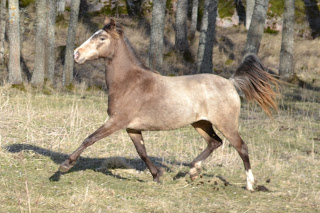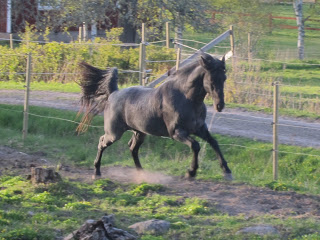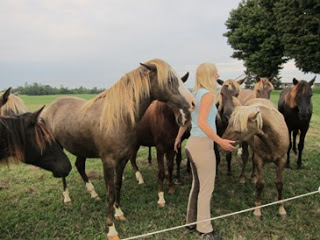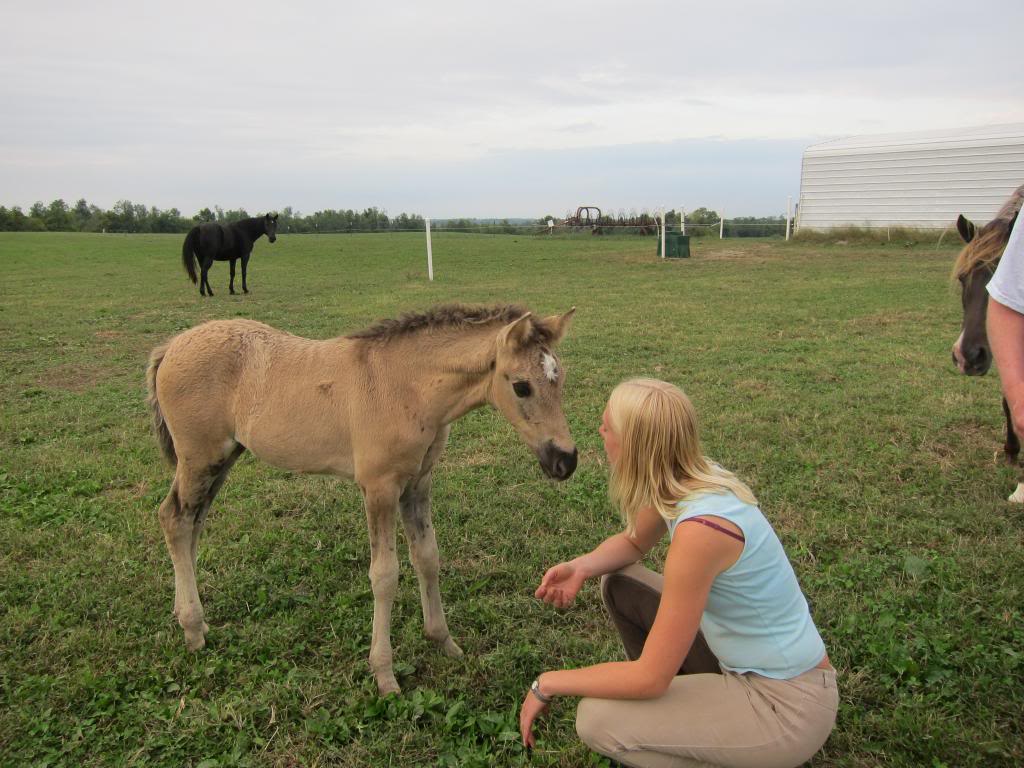Termometern har krupit neråt, -8 grader eller mer har det varit de senaste dagarna. Därmed har jag på kort tid fått frågan om hur hästarna klarar kölden, troligen för att de går på lösdrift. Först och främst upplever inte jag att det är någon större skillnad på lösdrift som utebox. Mina hästar står gärna inne i sina hallar och kan, om de vill, tillbringa mer tid där än om de stod på box. Dessutom kan de gå ett varv om de blir kalla för att få upp temperaturen lite.
Det jag tänkt skriva om är hästars köldtålighet. Av allt jag lärt mig ska normalhästen med vinterpäls inte ha några problem med temperaturer ner till – 15 och kunna klara temperaturer under det utan täcken. Kyla är inte ett så stort problem för hästen, den är anpassad till det (även om vi människor fryser). Förra veckan regnade det konstant i några dagar, vilket jag anser vara värre. Då riskerar hästarna att bli blöt genom pälsen vilket gör att de lätt börjar frysa, särskilt om det blåser och temperaturen ligger nära nollan. Därmed fick alla hästar täcken för att underlätta lite. Denna vecka ser de otäckta hästarna helt opåverkade ut.
För att underlätta för hästarna i kylan finns flera saker man kan göra:
· Fri tillgång till mat, kan hästarna äta när de vill kompenserar de för kyla mycket bättre.
· Ett bra väderskydd som alla hästarna i flocken får använda.
· Vatten som inte är iskallt är en bonus.
Man får inte glömma att hästar är individer och att anpassa efter det och hur man använder hästen. Just nu har jag två hästar med täcken och två utan. Percy och Bunny verkar opåverkade utan täcken och det är så de har genomlevt sitt liv tills de flyttade till mig. Calinka har jag, efter många år, lärt mig får ont i kroppen om hon inte har täcke och måste behandlas som en känslig porslinsfigur. För hennes del kan det räcka att vara utan täcke när det är ett par plusgrader så är det att boka tid med kiropraktorn. Sedan några år tillbaka kräver hon även halstäcke – annars får hon ont i nacken säger hon… Att överhuvudtaget borsta henne vintertid är ett projekt då jag inte vill låta henne stå utan täcken den minsta stund och ridningen sker självklart med ländtäcke. Pepper går också med täcke nu eftersom han verkar ha sträckt sig ett antal gånger i hagen under hösten. Jag räknar därför med att hans muskler är extra känslig, vilket jag också märkte när ”ontet” återkom lät honom vara utan täcke ett par dagar. I sammanhanget hjälper det säkert inte att han inte satt så mycket till vinterpäls så detta år får han gå med täcke. Nästa år får vi se.
Jag tycker också mängden arbete spelar in, en häst som blir svettig skulle jag inte släppa ut i denna kyla utan täcke. Då täcker jag heller redan tidigare på säsongen och hoppas på en något kortare vinterpäls, eller så klipper jag i värsta fall och lägger täcke på. Om hästen återkommer svettig gäller ett varmt täcke som andas och helst undviker jag för svettig häst när det är väl kallt. Däremot gillar jag inte att ha mer täcke på hästarna än vad som behövs. Återigen – individanpassning.
The temperature has been -8 degrees (Celsius) or less the last couple of days. I guess that, and the fact that my horses lives outdoors, is why I have gotten several questions about how my horses are doing with the weather. First of all, I don’t see a big difference between living outdoor and a nonisolated stall. My horses likes to stand in their shelter and can, if they like to, spend more time there than if they have been in a stall. And if they freeze they can just walk for a while.
I planned to write about horses cold tolerance; from all I have learned horse (with wintercoat) shouldn’t have any problems with temperatures to – 15 degrees (Celsius) and be able to stand temperatures below that without rugs. Cold isn’t such a big problem for horses as they have adapted to that (even if humans freeze). To my, last week’s constant rain was harder on the horses. Then they risk getting wet thru the fur and start to freeze, especially if it is close to zero degrees and windy. Therefore all wore rugs last week, this week the ones that don’t seem to be just as usual.
To makes it easier for horses is a cold weather it helps to:
Unlimited access to food – they keep warmer much better if they can compensate by eating.
A good shelter that all horses in the group is allowed to use.
Warm water is a bonus.
But, you can’t forget that horses are individuals and to compensate for that and the work they are supposed to do. Right now two of my horses wear rugs and two doesn’t. Percy and Bunny don’t seem to bother, and they have been living there lives without rugs before they came to be. After many years I have learned to pamper Calinka like a fragile queen, otherwise her body get soar. As little as a night without rug and a temperature just above zero can be enough to make it necessary to call the chiropractor. And since some years ago she also needs a neck cover – otherwise she tells me that her neck hurts… Just to brush her during winter is special as I hardly can get the rugs of her for a moment, and working her always demands exercise rugs. Pepper is also wearing a rug right now as he seems to have strained some muscles multiple times this autumn. Therefore I suppose his musckle are extra sensitive now and got that confirmed when he was without rug for a couple of days and got back his muscle stiffness. I guess it doesn’t help that he hadn’t put on a lot of winter coat either so this year he is going to wear rugs. Next one? – we’ll see.
I also think that the amount of work plays a part in how to dress the horse; I would not turn a wet horse back in the field during this time of the year without a rug. If I plan to work a horse hard I rather use rugs early and hope they don’t put on to much fur, and if they do clip them. With a sweaty horse a good rug is a must when they go back in the field. But, I don’t like to put on a lot of rugs if I don’t have to. Once again – individualization.











